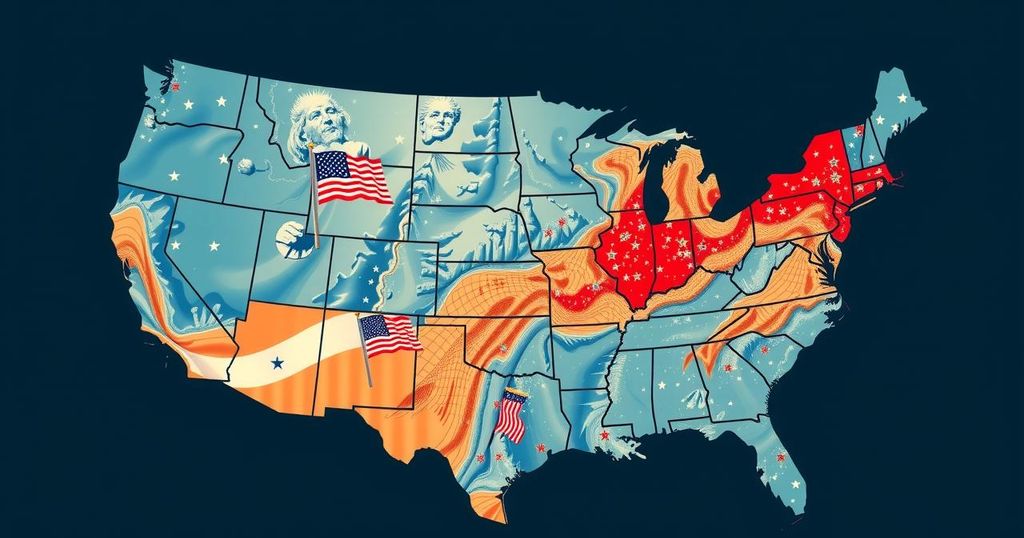The Uncertain Road to the 2024 U.S. Presidential Election
The American presidential election on November 5, 2024, showcases an unprecedented stability in polling, with Kamala Harris and Donald Trump locked in a statistical tie. The focus has shifted from persuasion to voter turnout, with both campaigns mobilizing efforts. Legal strategies are also anticipated post-election, particularly from Trump. Despite these dynamics, Harris is projected to win the election, although precise predictions remain elusive.
As the American presidential election approaches on November 5, uncertainty looms over the race between Kamala Harris and Donald Trump. Two pivotal observations underscore the current election landscape: first, a surprising degree of stability in polling results, and second, a statistical deadlock between the candidates that renders them too close to call. Despite heightened tensions including geopolitical conflict, assassination attempts, and the introduction of Harris as a new contender, polling averages have seen negligible fluctuations. Since Harris officially entered the race on August 1, her lead over Trump in national polling has increased from a mere 1.2 points to just 2.1 points by October 18. This level of predictability defies historical precedence, wherein elections have typically been marked by wide-ranging shifts. For example, past polls indicated more than 30-point changes in public opinion during previous contests, suggesting today’s polarized electorate is firmly entrenched in their preferences. Moreover, national polling uniformly indicates a statistical tie between Harris and Trump, with leads often falling within the margin of error. This makes precise predictions nearly impossible, contrasting sharply with earlier elections where clearer trajectories emerged at this juncture. In such a context, turnout is anticipated to play a more critical role than persuasion this November. To influence outcomes, electoral strategists are now focusing on two critical arenas: encouraging voter participation and ensuring the counting of votes aligns with their expectations. Initiatives aimed at mobilizing apathetic voters have gained traction, as evidenced by Harris’ extensive on-ground campaign aimed at driving turnout in key swing states. These operations employ thousands of volunteers trained to reach out to potential voters. Simultaneously, legal strategies to contest election results have been laid out, particularly by the Trump camp, which remains poised to litigate any unfavorable outcomes. Whereas past efforts appeared haphazard, Republicans this cycle have crafted a meticulously coordinated legal framework to challenge various electoral processes anticipated post-election. This marks a shift in the legal battleground from previous elections. Amidst this intricate electoral strategy, the forecast for the outcome remains ambiguous. Despite the pervasive uncertainty, one assertion emerges clearly: predicting election outcomes through data analysis is currently fraught with difficulty. Ultimately, the prediction appears to favor Kamala Harris, albeit without a solid analytical foundation to substantiate that claim.
The upcoming U.S. presidential election on November 5, 2024, between Kamala Harris and Donald Trump is marked by an unusual stability in polling despite various significant events that typically would influence electoral dynamics. In contrast to past elections characterized by volatility and significant shifts in voter sentiment, the current landscape displays a scarcity of movement in support levels for both candidates. The political environment has shifted towards ensuring turnout as the primary focus for both campaigns, redefining strategy away from persuasion towards mobilizing voters. Additionally, the potential legal challenges poised to arise post-election represent a new layer of complexity in what could unfold.
In conclusion, as the election nears, the landscape between Kamala Harris and Donald Trump remains exceptionally close with polls indicating a statistical tie. Despite various events that could influence voter sentiment, public opinion appears largely fixed. Turnout and the legal landscape following the election present crucial battlegrounds where both parties are exerting substantial efforts to establish an advantage. Predictively, while Harris appears favored at this stage, substantial uncertainty persists regarding the actual election outcome due to the unique complexities of the current political climate.
Original Source: ecfr.eu




Post Comment